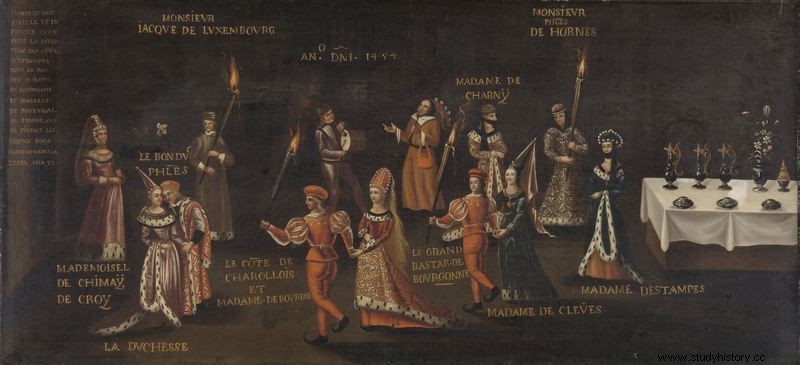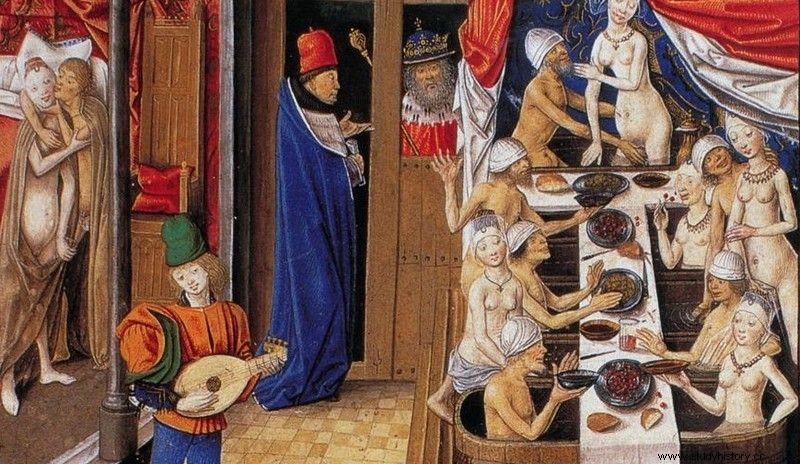While the common people were staring in the eye, the rich indulged in caricatured gluttony. Live birds in batter, fatty meat covered in garlic sauce, overcooked vegetables, all with the sound of gas released. These are the feasts of the kings of France.
The basis of the diet of the monarchs and the nobles of the Seine were primarily bread and various types of meat and pates. Their meaning has survived to this day in French, after all, the word meat ( la viande ) comes directly from the Latin vivenda , or "food". In turn, "companion" or "company" ( la compagne ) is derived from companaticum , which means "companion in eating bread." 
Bread was not only an element of the diet, but also the primary element of the tableware - sauces or soups were piled up with a hard slice that lasted a few days, and then - after the feast - they were to be given to the poor man or the dog. In the 14th and 15th centuries, grain consumption per person reached 200 kilograms per year!
Garlic sauce and almonds
Dried, smoked or salted meat was generously seasoned with garlic sauce or homemade mustard made of ground mustard and saffron. garum also survived to a certain extent until the Middle Ages . It was a sauce loved in Roman times, but disgusting in our modern opinion, made from fermented fish .

A group of poor travelers eat bread and wine. What like what, but cereals at the end of the Middle Ages were rarely lacking (source:public domain).
Of course, the tables also had desserts (most often pastries with jam or honey), wine and vegetables. The latter were rarely served raw, they were more often boiled or even mashed.
An essential addition to almost all dishes - both sweet and salty - were almonds, usually in the form of flakes or milk. In addition to the sweet taste, the acidity was equally valued. For this reason, the dishes were very often adorned with vinegar or juice from unripe grapes, called vertjus .
Tightening the belt
Even such sweet gluttony had to give way to strict fasts imposed by the Church. Abstention from eating meat, as well as milk, cheese, eggs, etc., was in force every Friday, and it was often respected also on Saturdays and Wednesdays. The same was true, of course, for the periods of Lent and Advent and the eve of major feasts. All these days together accounted for over a third of the year!

During fasting, fish were eaten with pleasure. They also included beavers, and in particular their fish-like tails (source:public domain).
Although some of the hosts rigorously arranged for their servants and comrades to go hungry, most found comfort in the fish. Mainly freshwater, marine ones were quite a rarity that almost only monarchs could afford! On Lenten days, more fruits and vegetables were also eaten, usually cooked. You could always get help on mixtum , that is, a peculiar "soup" of bread and wine.
Masterpieces of chefs
The feast was a natural remedy for the boredom that often prevailed among the high society. Its setting had to be appropriately sophisticated, and the more impressive it was, the better the host fared in the eyes of the guests. It was not only about the multitude of rich dishes or musicians, but also about making the main character of the feast - food, an attraction.
A skilled chef could boast, for example, huge cakes, inside which there were whole troupes of artists , ready to perform right after unleashing the baking. It is even better if live birds were flying out of the cake, astonishing and admiring the guests. The real arms race in this area has led to the inventing of increasingly strange tricks.

A painting by an anonymous author showing the "Pheasant Feast". Unfortunately, the creator did not focus on the fabulous amount of food that appeared on the tables (source:public domain).
If the artist-cook wanted to make a bakery look raw, he rubbed it with a powder obtained from drying blood in the sun . His competitor could match him by cutting strings of lyre and throwing them on the meat, creating the illusion that ... worms are walking on the dish . Another thing is, whether such shows sometimes deprived the guests of appetite.
The best chefs could count on prizes worthy of their craftsmanship. The famous Taillevent, who cooked for the kings of France, obtained nobility for his culinary merits.
Pheasant feast
The apogee of such performances is already at the end of the Middle Ages and the fabulous Pheasant Feast, organized by Philip the Good, Prince of Burgundy. Apart from the fact that the guests ate their host with 9,000 loaves of bread, 32 barrels of wine, 800 pates, over 3,000 roasted pigs and calves, 1,400 hares and many other dishes, they also had a chance to observe a unique spectacle.
Wanting to encourage his subjects to crusade against the Turks, the prince organized a truly remarkable performance. The Byzantine Church was represented by an actor led by Saracen on an elephant, and a touching song was performed by a 12-year-old child seated on a deer, who was said to also sing. At the end, the ruler made an oath that he would take Constantinople from the hands of the infidels. He did it in the presence of a live pheasant, hence the name of the feast. What an impression she must have made on the guests, since we are still talking about her after nearly six centuries!
A feast in caricature
The authors of fabliaux made fun of all this overeating and glamor that is coarse and satirical poems. Their bluntness, and sometimes even primitivism, can be shocking to us. Nevertheless, it is worth seeing how they portray the gluttony of medieval France.
Feasts rich in large amounts of fatty meat in intense garlic sauces, of course, had repercussions in the form of frequent flatulence. The gas release was not even attempted to cover up. This topic was raised by the author of "Le pet du vilain" (literally "Peasant Fart"), an unrefined piece that can be treated as a warning against overeating.
The protagonist of the story is a peasant who abused fatty foods and garlic, who got terrible flatulence. Even the devil himself mistook the sound of the release of digestive gases for the sound of the soul leaving the body . Satan grabbed the product of the goblet in the sack and rushed home. The mistake was revealed only in Hell and significantly spoiled the atmosphere there. It is difficult to imagine the rulers as the heroes of this type of story, but you can guess that after the feasts described above, their gastric problems were even greater.

The perfect combination for fabiliaux, i.e. food and eroticism (source:public domain).
Even more often the theme of fabliaux there were also blunt combinations of sex and food, with the names of the dishes mostly used as love jargon . The pioneer in this field was the thirteenth-century author Adam de la Halle, acting under the patronage of Count Artois (father of the famous Mahaut and grandfather of Robert d'Artois, immortal heroes of Maurice Druon's "Damned Kings"). In his "The Marriage of Robin and Marion" he described the intentions of the heroes, likening them to eating a capon together using the "mouth to mouth" method.
Bibliography:
- Food and eating in Medieval Europe, Martha Carlin, Joel T. Rosenthal, Hambledon Press, London 1998.
- Sarah Gordon, Culinary comedy in Medieval French Literature, Purdue University Press, West Lafayette 2006.
- René Husson, Philippe Galmiche, Medieval cuisine, Oficyna Naukowa, Warsaw 2015.
- Régine Pernoud, The Woman in Cathedrals , Ed. Książnica, Poznań – Katowice 2009.
- Melitta Weiss Adamson, Food in Medieval Times, Greenwood Press, Westport 2004.
